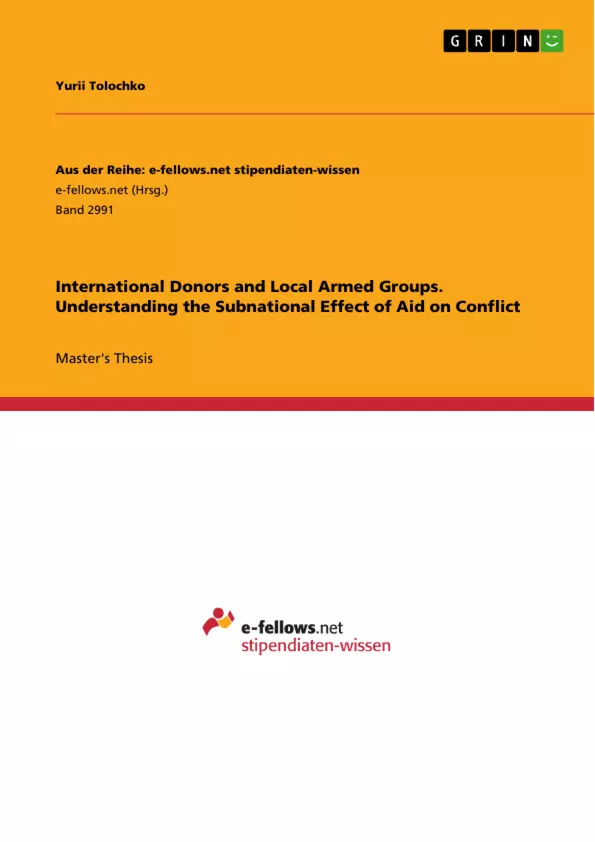Research on the relationship between foreign aid and conflict has been focusing primarily on the country level of geographical aggregation. First of all, this approach disregards any geographical variation of the events and simply assumes that conflict as well as aid in a given year is evenly distributed across a given country. Secondly, it is susceptible to many problems stemming from limited number of units of analysis. Moreover, most of the topical scholarship attempts to establish the existence of a relationship in and of itself, without disaggregating by the type of donor and type of environment where aid flows to. The results of many studies show no clear consensus and often contradict each other.
This work bridges the existing gap in literature by examining the relationship between foreign aid and the conflict intensity on a level of subnational administrative units (ADM1).
The primary distinctive feature of this work is that aid projects are classified according to the developed and justified indices of donors’ adaptability and local environment’s receptivity. The data encompasses 5 African countries with the timeframe from 1998 to 2009 without gaps in coverage. An alternatively coded dataset which focuses on DRC with the timeframe of 1998 to 2014 is used for purposes of additional validity. In contrast to most other published research, the results indicate that there is no significant association between foreign aid and the level of conflict. Additionally, the hypotheses that the relationship is contingent on the adaptability and receptivity scores are also refuted. Disaggregating aid by fungibility also does not provide a significant link between aid and conflict. The implications of these findings are discussed, especially with respect to the contradictory findings in the existing literature. Measures and recommendations are devised both for future research avenues as well as for the broader audience, particularly for the actors responsible for international aid.
Inhaltsverzeichnis (Table of Contents)
- Abstract
- Introduction
- Theoretical Background
- Current state of research
- Economic development and conflict
- Foreign aid and conflict
- Justification for ADM1 level of precision
- Measures of adaptability and receptivity
- Hypotheses
- Research design and estimation framework
- Data
- Data sources
- Chosen countries
- Descriptive statistics of the data
- Results
- Discussion
- Conclusion
- APPENDIX A
- APPENDIX B
Zielsetzung und Themenschwerpunkte (Objectives and Key Themes)
This thesis aims to explore the relationship between international aid and conflict intensity at the subnational level. It specifically examines whether aid can contribute to conflict reduction or, conversely, exacerbate existing conflicts. The study utilizes a novel approach by classifying aid projects based on indices of donor adaptability and local environment receptivity, providing a more nuanced understanding of aid's impact.
- Examining the relationship between foreign aid and conflict at the subnational level.
- Classifying aid projects based on donor adaptability and local environment receptivity.
- Investigating the potential for aid to mitigate conflict or exacerbate existing conflicts.
- Analyzing the influence of aid fungibility on the relationship between aid and conflict.
- Providing insights and recommendations for aid donors and future research.
Zusammenfassung der Kapitel (Chapter Summaries)
- Abstract: This section summarizes the key findings of the thesis, highlighting the unique approach of examining aid-conflict dynamics at the subnational level and employing indices to assess adaptability and receptivity.
- Introduction: The introduction sets the stage by outlining the global trends in conflict and poverty, emphasizing the disproportionate impact of conflict on poverty reduction in Sub-Saharan Africa. The thesis argues for a deeper understanding of the relationship between aid and conflict, considering their interconnectedness and the potential for aid to exacerbate conflict.
- Theoretical Background: This chapter delves into the current state of research on the relationship between economic development, conflict, and foreign aid. It highlights the limitations of existing studies, particularly their reliance on country-level analysis and the lack of differentiation in aid types and recipient environments.
- Data: This section details the data sources and methodology used in the study. It discusses the selection of countries, the time frame for data collection, and the descriptive statistics employed to analyze the data.
Schlüsselwörter (Keywords)
This thesis focuses on the subnational impact of foreign aid on conflict intensity, utilizing indices of donor adaptability and local environment receptivity to understand the relationship between aid and conflict. Key terms include: subnational analysis, foreign aid, conflict intensity, adaptability, receptivity, aid fungibility, and Sub-Saharan Africa.
- Quote paper
- Yurii Tolochko (Author), 2018, International Donors and Local Armed Groups. Understanding the Subnational Effect of Aid on Conflict, Munich, GRIN Verlag, https://www.grin.com/document/448515



